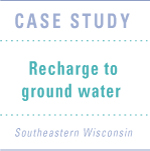NATURAL RECHARGE TO GROUND WATER

The major source of water to the ground-water flow system is precipitation in the form of rain and snow that infiltrates the land surface, moves downward through the unsaturated zone, and enters the water table as recharge. Water that is evaporated or transpired by plant roots as it percolates to the water-table surface is not ordinarily counted as recharge.
The amount of recharge can vary considerably across the landscape depending
on the soil type, precipitation (rates, types, timing, and amount), vegetation,
the slope of the land surface, and other factors. The cross section below shows
an area of relatively high recharge below a small depression in the land surface
which collects runoff and focuses flow downward:
Urbanization changes the natural rate of recharge by adding impervious
surfaces (rooftops and pavements) and storm sewers. Irrigation water diverted
from surface water can be an important way of locally increasing recharge to
the ground-water system in agricultural areas (irrigation is only a minor source
of water in southeastern Wisconsin ). Wells by themselves have little effect
on the natural rate of recharge, but under some circumstances they can reverse
natural gradients and result in transfer of water from streams to the ground-water
system.
|